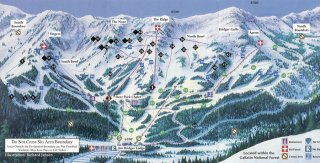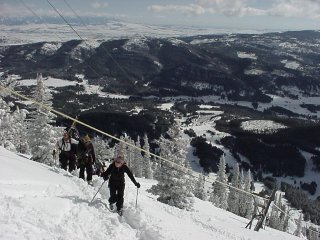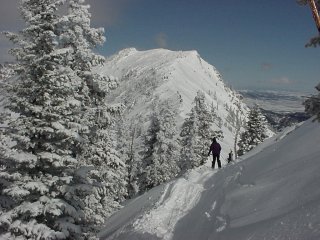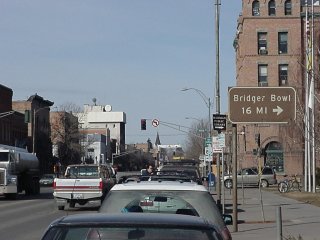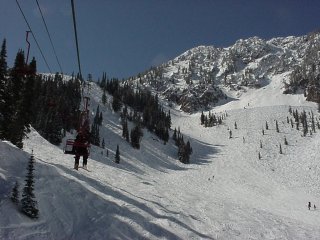Bozeman, MT – “One if by land, two if by sea.” The code for the light
signals emanating from Boston’s Old North Church during the American Revolutionary
War was clear enough.
Equally clear is the signal cast by Bozeman, Montana’s call to arms, a single
blue light flashing high above a tall building on the city’s main thoroughfare.
Should neighboring Bridger Bowl Ski Area receive two inches or more of fresh
snowfall, the blue beacon is activated for all to see … and know. While Bridger
Bowl is becoming increasingly known to destination travelers, it still is first
and foremost a community ski area. So thoroughly does the skiing at Bridger
Bowl intertwine with the pace of life here that roughly 10% of the Gallatin
Valley’s 50,000 residents possess a Bridger Bowl season pass. A quick scan
of town, home to Montana State University, finds a clear predominance of not
only bars, as expected, but also ski shops.
The light is viewed by some as a necessity, for though the back of the southernmost
ramparts of the Bridger Range loom directly overhead on the northern edges of
town, the weather there may be startlingly different from that experienced on
Main Street. The Bridgers run due north-south, forming an impressive barrier
to trap moisture streaming eastward across the southwestern Montana lowlands.
Add a little bit of orographic lift generated by the height of the Bridgers,
which approach 10,000 feet, and some blow-in as the prevailing winds deposit
snow in the lee of the ridge, and you’ve got a recipe for 350 inches annually
on some of the most challenging in-bounds terrain that you’re likely to find
anywhere. By contrast, the city of Bozeman only achieves an annual snowfall
average of 83.5 inches.
|
The Ridge |
Bridger Bowl’s personality is clearly defined by The Ridge, two full miles
of high-altitude ridgeline spanning from one end of the resort to the other.
Chairlifts bring you 2/3 of the way there from the parking lot, but your own
low-speed quads are required to ascend the upper third of the mountain and access
The Ridge. How serious is this terrain? An avalanche transceiver, a rescue
shovel, and a partner are mandatory equipment. That serious.
FINALLY!
We had driven north from sparse snow conditions in northwestern Wyoming. Word
had reached us that during what had clearly been a lean snow year in the entire
region, five fresh inches had fallen at Bridger earlier in the week. An inauspicious
figure, to be sure, but more than we’d managed to bankroll thus far on this
trip. More promising were the bands of moisture that we had seen on weather
radar which had narrowly escaped our grasp 24 hours earlier, as they had passed
just north of our Wyoming location. We held cautious optimism that they had
perhaps delivered a couple of fresh inches to our next destination.
We fought hard on the drive north to find cause for optimism. “Gee, that almost
looks like a fresh dusting on those old snowbanks, doesn’t it?!” By the time
we neared the turnoff for Big Sky Resort, that dusting had grown to no more
than two inches. Still, the way things had been going on this trip, those two
inches constituted grounds for excitement.
Nothing, however, prepared us for the information contained in Bridger’s snow
phone report, accessed from our motel room upon arrival in Bozeman: 12 inches
of new snow a day earlier, on top of the five inches that had fallen five days
before that, and both The Ridge and North Bowl had been closed all day due to
avalanche work. Both would open in the morning for the first time following
the snowfall. Montana State was on spring break, so competition for fresh lines
would be lessened significantly as students, weary of a long, cold Montana winter,
had long since departed for sunnier, warmer climes. What could be better?
How about two additional inches of white gold by dawn the next day, for a total
of 19 new?
Rising in the morning wasn’t difficult. Neither was booting up.
|
(Click on image to open a full-size trail map in a new
Packs line the start of the Ridge hike
Hiking the Ridge
Extraordinary scenery
Atop the Ridge |
Bridger Bowl boasts 1,500 skiable acres draped over 2,600 vertical feet. Nine
hundred of those acres and 2,000 vertical feet are lift accessed by 1 quad lift,
1 triple and 5 double chairs. There are 69 named runs, with the longest one
being 3.5 miles in length. Most of the area offers wide, open terrain with a
variety of landscapes, including long slopes, glades, chutes, and gullies, in
addition to several small bowls.
We boarded the Powder Park quad chair, one of only two lifts at Bridger that
isn’t an old Riblet center-pole double. A short skate brought us to the Bridger
Lift for the second part of our journey skyward.
The third “lift” used to access The Ridge was by far the most difficult. Atop
the Bridger Chair, a long string of racks holding daypacks and backpacks leads
to the start of an arduous ascent of approximately 400 vertical feet at slopes
sometimes reaching 35 to 40 degrees. “Bridger over the years has historically
developed the high-end skiing with The Ridge and that whole backcountry experience
requiring shovels pieps and partners to go on the mountain, ” explained Bridger
Bowl Marketing and Sales Director Doug Wales, “and all the steep chutes and
gullies, glades and scree fields that you can ski off of up there provide a
wide range of very backcountry experiences that you can get into within a ski
area. Certainly other areas are starting to open up terrain to offer some of
that experience, too, but I think Bridger offers more of a variety because you’ve
got two miles of ridgeline to work off of.”
“Back about 25 or 28 years ago, they opened up skiing on The Ridge to the public,”
Wales continued. “They had to control The Ridge anyway, so they figured to
let people ski it up there. Back in those days, there were only a handful of
people who would go up there. When I started skiing it in the ’80s, there might
be a couple of dozen people on The Ridge on any given day, and you knew everybody
– it was a pretty tight group of people. Certainly it was not as big then as
it is now. Now you can get up to 1,400 people on The Ridge in a day.”
The iron men and women on the climb led a blistering pace, and more than once
we found ourselves stepping to the side to allow those with more stamina to
pass. While the line of skiers and riders ascending The Ridge was far from
constant, the assault of groups stopped only for smaller gaps between the groups.
Making matters yet far worse for our psyche was the new ski patrol poma lift
adjacent to the bootpack route, which occasionally fired up to lift a patroller
effortlessly to the top of the ridgeline. Restricted to patrol use only, although
its purpose is clearly justified, these fortunate patrollers remained barely
outside of the reach of the sharp tips of our ski poles. True torture.
A small group congregated atop the ascent for photos, infusions of water, clicking
in, or merely (perhaps in our case only) to catch one’s breath before pushing
off in one direction or the other.
Considering that the skiers and riders observed at Bridger possessed perhaps
the highest average skill level that we have observed anywhere, attitudes were
noticeably absent here. No arrogance, no deadly competition for fresh lines,
no “look at me” poses. Folks quietly donned their packs, shouldered their skis
and headed to their own personal paradise to accomplish amazing feats to please
only themselves. “You’ll arguably find some of the best skiers percentage-wise
that you’ll find anywhere in the states,” Wales confirmed. Some of the top
extreme skiers in the world cut their teeth on The Ridge, including Scott Schmidt,
Doug Coombs, Emily Gladstone, Tom Jungst and Jim Conway.
Most folks headed north, as did we, to a low col before (ugh!) taking
off one’s skis again to ascend further. Eventually reaching a traverse, it
was time to step into our bindings again as we followed our tour guides, the
aforementioned Wales and Sales Director Rob Wales (amazingly, no relation) across
numerous slide paths to our chosen destination: Bridger Gully.
We dove into the narrow chute, whose rock walls closed in menacingly before
opening into a broad apron of untouched powder. The sensation of gliding down
the precipitous slope through admittedly heavy thigh-deep snow was truly what
brought us to Montana in the first place, and at last after seven days of desperate
searching, we had found it.
RARE IN THE INDUSTRY
Bridger Bowl is a private, nonprofit ski area. Since there are no owners, all
profits are invested back into the area for improvements and operational budgets,
providing a high quality ski experience for a very reasonable price. Bridger
Bowl’s charter even stipulates that it provide a quality ski experience for
local families.
“Bridger Bowl has been a non-profit organization for 40 years now,” explained
Wales, “and historically has offered very affordable skiing to the local community.
“
1955 was the first year of operation for Bridger Bowl, but the year before
that the Bozeman Area State Recreation Park fired up a rope tow bringing skiers
all the way to the traverse line to climber’s left of where the Bridger Chair
presently unloads. Locals had an existing ski area in Bear Canyon, about five
miles east of Bozeman, but it had a lower elevation and significantly less snowfall,
so ski activities moved over to Bridger Canyon after a deal was negotiated with
the state of Montana for use of public land. It was agreed that Montana State
University, as a land-grant school, would receive the proceeds from any sale
of the ski area.
|
The Pierre’s Knob lift |
In explaining Bridger Bowl’s operating structure Wales advised, “We have an
association of skiers that elects a nine-member board of directors. To belong
to the association of skiers you have to be a Montana resident, and pay a $25
initiation fee $5 annual dues, and then you can elect board members or run for
the board, or help establish or vote on any association by-law changes. There
is a general manager who is hired by the board, and each department has hired
staff. There’s absolutely no stockholder ownership whatsoever like at Mad
River Glen. All the money that Bridger makes for a profit goes back into the
ski area. “
Even more rare in the industry, Bridger Bowl is presently a debt-free operation.
“We haven’t always been debt-free,” cautioned Wales, “as we have had at times
a long-term bond going when we developed the Pierre’s Knob area and the Virginia
City chair. That was in the late ‘70s, and the ‘80s were kind of tough for
Bridger as the economy in Montana was pretty flat. In the ‘90s Montana got
discovered, so we saw a huge change and we were able to pay off all of our debts
– we bought the new Powder Park chair, built the mid-mountain Deer Park chalet,
and paid for that out of pocket and got money in the bank. Hopefully, that’s
the way that we’ll keep going. Bridger’s been going very well for the past
few years. We’ve been operating at a 40% profit to expense ratio, and debt-free.”
|
Bridger Bowl is only 16 miles from downtown Bozeman |
Wales also discussed their financial status vis-à-vis future plans at Bridger.
“We are looking down the road at putting in an additional facility in the base
area, so hopefully we won’t have to borrow very much and if we do, it won’t
be more than for five or six years.”
Bridger Bowl is presently considering expanding their terrain along both ski
area boundaries, but don’t look for anything in the immediate future. “We’re
looking north and south right now, in terms of expanding into Slushman’s Ravine
and over into Bradley Meadows beyond what we have now,” explained Wales. “Right
now that’s under environmental impact study. That’s for future growth as we
need to expand. We’ll do that as we feel pressure to grow bigger.”
With 168,000 annual skier visits dispersed over 1,500 skiable acres presently,
that pressure isn’t likely to reach the breaking point any time soon.
HOW CHEAP?!
Bozeman, 16 highway miles away, serves as the main bed base with most of the
lodging and entertainment options, although a couple of lonely lodging options
exist near the resort or along the road through Bridger Canyon leading to the
ski area.
Cruising, bumps or steeps … the choice is yours at |
“Bridger Bowl has always grown as the business has allowed,” Wales reflected.
“It’s never been a forced development, and Bridger Bowl doesn’t have any plans
to get into the lodging business. In the past there was an effort to develop
some private land to the north of our base area, and the 25-year-old master
plan allowed for some type of development up here, but at its biggest point
it was planned to be a small thing. Over the course of the ‘90s, we’ve done
so well that we realized that we don’t need to push that kind of business.
There’s a big bed base in Bozeman. Our primary business here at Bridger is
to provide the local skiers and boarders with a place to ski, and the destination
business that we do has a role in keeping the prices down.”
Despite its strong day-skier market (53% of their skier visits are via a season
pass), over 30% of Bridger Bowl’s visitors come from outside of Montana. The
ski area coordinates central reservations with most of the area’s lodging properties
at amazingly low rates; their Powderhound Package offers four days of skiing
and four nights of lodging starting at $138.00 per person, quad occupancy, due
to their program of offering the fourth day and night free. Think about it
– that’s $34.50 per person, per day for a lift ticket and a bed, and
even continental breakfast at most hotels. Available properties include national
franchises such as Sleep Inn or Ramada Inn Limited. This package is available
at all times except for the Christmas holiday week, when the starting price
increases to $196.00 per person, but for 5 days and 6 nights. Prices listed
were valid for the 2000-2001 winter season.
The city of Bozeman is home to restaurants, shops, galleries, microbreweries
and, as previously mentioned, bars. Its status as a university community supports
a strong cultural presence, with a wide variety of music available ranging from
country music to jazz, with national headliners occasionally stopping in town
while en route between larger venues. “Bridger is 20 minutes from town, and
a university town at that – a very young, active community,” enthused Wales.
Non-ski diversions include The Museum of the Rockies, home to an extensive dinosaur
exhibit among its offerings.
Alternative winter recreation is available in nearby Yellowstone National Park,
90 miles to the south. The nearest alternative ski destination is Big Sky,
just shy of an hour to the south via U.S. highway 191, although Red Lodge, Jackson
Hole, Grand Targhee, Showdown, Discovery Basin, and Great Divide are all a reasonable
drive away.
GETTING THERE
Flights are available into Bozeman’s convenient Gallatin field, only 24 miles
from the ski area, aboard Northwest, Delta, Horizon Air and Sky West. The airport
is situated within the broad Gallatin Valley, which lacks the challenging mountain
approaches facing flights arriving at some other western ski destinations.
Some lodging properties offer ground transport from the airport, and Bridger
Bowl arranges limited shuttle service to the ski area, or if you prefer, several
national car rental agencies are located at the airport. If you’re driving
to Bozeman, the city is conveniently located right on Interstate 90 between
Billings and Butte.


